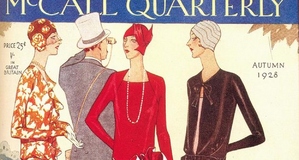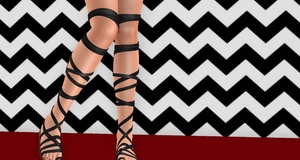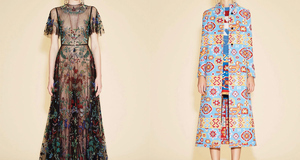Featured Article:Women's Fashion and the Renaissance: Considering Fashion, Women's Expression, and Sumptuary Law in Florence and Venice"What More Can Harlots Add?"After describing the fashions of women of his time, one mendicant friar begged the question, “What more can harlots add?” (Hughes, 1992, p. 147) What more, indeed. Women clearly paid a great deal of attention to the design of their clothes (Birbari, 1975, p. 10). Most of what we know about Renaissance fashion comes, naturally, from written descriptions and artistic interpretations. The actual physical evidence, with the exception of bits and pieces of fabric housed in museum collections, is long gone. We must, then, make conjectures about the nature of clothes during this period. Though a good deal of written descriptions exists, these descriptions describe only those elements deemed remarkable by the author of the description, thus leaving holes in the descriptions. In the case of sumptuary law prosecution records, for example, only the element of the clothing deemed objectionable is mentioned. Art sources allow for a more visual experience, though uncertainty over the exact type of garment and its precise color arises with some frequency. Artists were not, after all, overly fixated with the perfect representation of his subject’s fashion and there is certainly plenty of artistic license. Written and artistic portrayals combined, however, allow us a decent understanding of the fashion of the time (Frick, 2002, p. 147-149). Women’s attire during the Renaissance was composed of four layers: the chemise, the dress, the over-dress, and, when in public, the cloak (Frick, 2002, p. 147-149). In the fifteenth century, the dress was commonly separated into a bodice and skirt, connected at the waist, which allowed for greater variability in style. However, the greatest variability was in the details. The bodice could either hang freely, much like a man’s tunic, or be separated down the middle and joined together with lacing. The sort of pleating of the skirt varied from cartridge pleats that fanned out to wide box-pleating (Birbari, 1975, p. 48-55).4 Alternatively, the skirt could be gathered with a drawstring or rigidly held away from the body with a farthingale (Hughes, 1992, p. 149). Similarly, necklines could be gathered with a drawstring or cut in a variety of shapes that needed no adjustment. Sleeves provided greater variety still. As separate pieces tied to the rest of the dress later, the sleeves often contrasted with the body of the dress and could leave parts of the chemise exposed either by joining the seams at intervals or by slashing—deliberate cuts in the fabric of the sleeve. Sleeves could be tight, tapered, or wide “winglike fantasies” (Frick, 2002, p. 192). Venetian women in particular were fond of elaborately decorated tight upper sleeves and puffed lower sleeves (Birbari, 1975, p. 64-71). Contrastingly, Florentine women preferred more natural silhouettes. Greater variation still was possible with different materials, fringes, ruffs, buttons, ornaments, jewels, embroidery, belts, headdresses, and shoes. Around twenty terms for various dress ornaments appear in family accounts, thus exemplifying the variety possible with just accessories (Frick, 2002, p. 158-160). These were the adornments and variations that consumed lawmakers (Hughes, 1983, p. 71)."Stooping to Voluptuousness"Lamenting the state of women’s dress, Laura Cereta exclaims in her letter, “O the bold wantonness of lost modesty! O the weakness of our sex, stooping to voluptuousness!” (In Bartlett, p. 194) However, women certainly did not embrace fashion simply for reasons of voluptuousness. A far greater motive—the desire for expression and self-definition—was evident in women’s clothing choices. Fashion for women was, simply put, fantasy. Career and socio-economic standing already defined men’s place in society; women lacked such definite social classification. Instead, women, patrician and poor alike, could take advantage of fashion to transform themselves in a game of “social negotiation” (Hughes, 1992, p. 155-57). As a Milanese cleric would remark about Venetian women, “those [women] who are able as well as those who are not, dress very sumptuously” (In Allerston, 2000, p. 367). Italian women were especially open to fashion’s self-defining qualities; unlike women in other European countries, they had absolutely no opportunity to exercise feudal power or take up a trade (Hughes, 1992, p. 155-157). Clothes became, thus, women’s manner of distinguishing themselves (Hughes, 1983, p. 87). “The coming of fashion created a new world, in which a passion for novelty, combined with rapid changes in taste, interrupted a tradition of well-established habits in ways of dressing and the significance attributed to clothing,” Carlo Marco Belfanti wrote in his article “The Civilization of Fashion: At the Origins of a Western Social Institution,” perhaps expressing best the changes that rocked 14th-century Italy (2009, p. 261). By the fifteenth century, Florentines were spending to excess on clothing: a relatively obscure family, the Martellis, had a wardrobe worth the equivalent of several large houses (Laufenberg, p. 23). Women, in particular, however, seem to have embraced the possibilities of fashion. As Vecellio tellingly remarked, “…instability and love of variety … are common among women” (Hughes, 1992, p. 142). Clothing was, furthermore, for the first time, thought of as offering a window on the individual (Allerston, 2000, p. 367). Thus, Italy fast developed into a society that defined itself by its clothes (Hughes, 1983, p. 88). As already described, a full-length cloak covered much of a married woman’s attire when in the streets and was designed to keep her invisible. Wealthy women were not dressed for the view of commoners in the street anyway. Dressed entirely in expensive cloth, elevated with platform clogs, and surrounded by an entourage of servants or kinswomen, often similarly dressed, women in the streets were something of an “imposing mass of fabric,” to borrow Carole Frick’s phrase (2002, p. 154-57; 163).5 Beneath their cloaks, however, women were able to expose their many luxurious layers through slashing and snips in the outer-dress and dress. Often, women added to this effect by lifting their outer-dress to expose a luxurious contrasting layer beneath or a fine trim (Frick, 2002, p. 159-60). This third layer, which served no functional purpose, was the layer that was worn specifically for expression and thus served the greatest social purpose. Naturally, the outer layer, especially the sleeves, was the most opulently decorated with ornaments and embroidery (Frick, 2002, p. 197). As Alessandra Strozzi urged her son in a letter on wedding dresses, “…if the fabric [of the gown] is not adorned with pearls, one must decorate it with other trifles…” (Frick, 2002, p. 163). Women and men alike took care to concentrate the majority of individualization and fabric on the upper part of the body, thereby allowing them to occupy a greater area of space and thus extend their control over that area, projecting a sense of power. The lower portion of an outfit, however, was more uniform (Frick, 2002, 157-59). Typically, the only distinctive element below the bodice was the shoes. While men’s footwear was certainly more obvious, women’s footwear was still noticed. Because feet were considered a very humble, but sensual part of the body, extravagant footwear, such as gilded shoes, “flirted with ostentation” and “underlined status, emphasized honor, and provided a particularly splendid appearance,” as Michelle O’Malley described (2010, p. 71-72). Color “differentiated the great from the near great,” in Carole Frick’s words (2002, p. 170). During the Renaissance, colors lost their medieval symbolic significances in favor of selecting what best flattered a woman’s natural coloring (Hughes, 1992, p. 156), a concept echoed in Leon Alberti’s The Family in Renaissance Florence when Giannozzo instructs Lionardo to choose “whatever bright colors suit the wearer best” (1969, p. 194). Yet while many colors lost their significance during the Renaissance, black became associated with piety, seriousness, solemnity, and authority in the late 15th century (Frick, 2002, p. 174). As Ludovico Dolce wrote from 16th-century Venice, black “shows likewise firmness, because this colour can not change to another” (Belfanti, 2009, p. 265). Overwhelmingly, however, traditional meanings of colors were subordinated to the expense of various dyes and the resulting honor expensive dyed cloth could afford its owner. Red chermisi was the favorite—and most expensive—hue in both Florence and Venice, in particular the expensive deep scarlet created by kermes dye. Equally expensive was alessandrino, a deep blue hue (Frick, 2002, p. 101-03). Rich colors such as these were boldly juxtaposed in an outfit: contrasting gowns and linings, bodices and sleeves, etcetera, to create a striking and sumptuous appearance (Frick, 2002, p. 170). Such pairings certainly were not incidental.Continued on Next Page » Suggested Reading from Inquiries Journal
Inquiries Journal provides undergraduate and graduate students around the world a platform for the wide dissemination of academic work over a range of core disciplines. Representing the work of students from hundreds of institutions around the globe, Inquiries Journal's large database of academic articles is completely free. Learn more | Blog | Submit Latest in History |
















